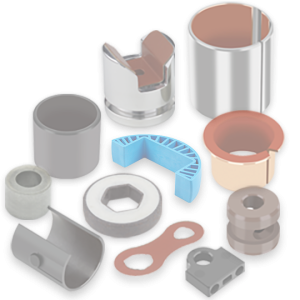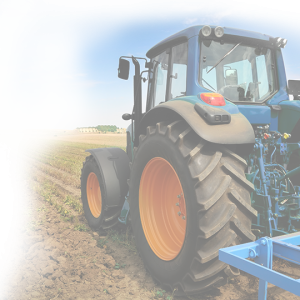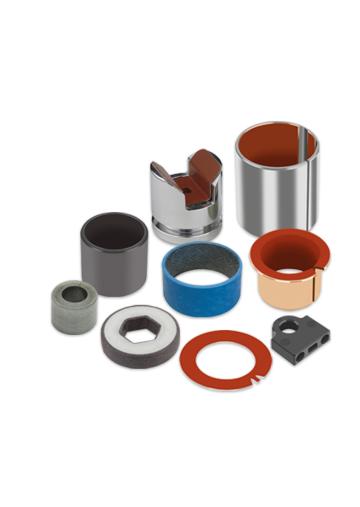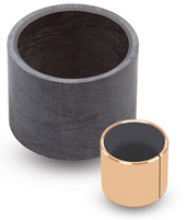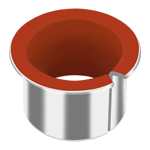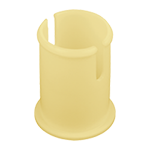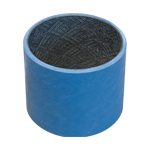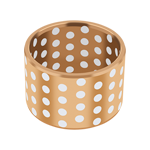A VARIETY OF LOW FRICTION BEARING MATERIALS
Metal-polymer plain bearings consist of a metal backing, usually steel or bronze, onto which is sintered a porous bronze layer that is then impregnated with PTFE and additives to obtain a running surface that offers anti-friction and wear resistant bearing properties. These bearings can operate dry or with external lubrication.
Plain bearings also may be made of engineered plastics, which provide excellent wear resistance and low friction in both dry and lubricated operating conditions. Being injection molded, they can be designed to almost any shape and produced from a variety of resins compounded with reinforcing fibers and solid lubricant. These bearings exhibit excellent dimensional stability, low coefficients of friction and good thermal conductivity.
Fiber reinforced composite bearings are another form of plain bearing that consists of a filament-wound, fiberglass-impregnated, epoxy backing with a variety of low-friction, wear-resistant bearing linings. This structure enables the bearings to support high static and dynamic loads, while their inert nature makes them suitable for corrosive environments.
Monometallic, bimetallic and sintered bronze plain bearings are designed for use in both land-based and submerged industrial applications under high load with slow speed movements. Solid bronze bearings impregnated with lubricant provide maintenance-free performance in high temperature applications, whereas monometallic and bimetallic bearings are designed for lubricated applications.
ROLLER BEARINGS
Rolling-element bearings utilize balls (ball bearings) or cylindrical rollers (roller or “needle” bearings). These elements are contained with bearing rings or “races”, where they facilitate motion with little resistance to sliding. Ball bearings, the most common type, can accommodate both radial and axial loads.
However, rolling element bearings are subject to failure modes such as brinelling, when the race is deformed by the rolling element due to load or the balls deform if they are overloaded, false brinelling, due to repeated loads under static conditions, as well as wear due to insufficient lubrication with oscillatory movements. Designed for heavier loads, cylindrical roller bearings have greater contact with the races, spreading the load over a larger area. However, they are not well suited for applications involving thrust loads.
PLAIN BEARINGS VERSUS ROLLER AND NEEDLE BEARINGS
There are significant differences between plain bearings and roller bearings preventing them from being used interchangeably
- Because of their complex, multi-component design, precision construction and exacting installation, rolling-element bearings tend to be considerably more expensive than plain bearings
- Rolling-element bearings are better suited to applications requiring precise shaft location and/or extremely low friction
- Because of their greater contact area and conformability, plain bearings provide higher load capacity and resistance to high shock loads and edge loading
- Plain bearings compensate misalignment better than certain rolling-element bearings to reduce the impact from edge loading
- The slim, one-piece design of plain bearings enable to reduce housing size for substantial space and weight savings
- Plain bearings offer greater resistance to damage from oscillatory movements for improved bearing life
- Plain bearings are not subject to wear damage resulting from the skidding of the rolling-elements when operating at high speed and too low load and exhibit superior damping properties
- The absence of internal moving parts in plain bearings results in quieter operation and almost unlimited speed ratings under properly lubricated systems than rolling-element bearings
- Straightforward installation of plain bearings into simple machined housings virtually eliminates fitting damage compared with rolling-element bearings
- Non metallic plain bearings offer improved corrosion resistance compared to standard rolling-element bearings
- Plain bearings can operate dry eliminating the additional cost of lubricant systems, lubricant and equipment downtime during maintenance
- Plain bearings can operate dry at high temperatures and with the presence of contaminants
Related links:
- Wikipedia: to learn more about the different uses of mechanical bearings

